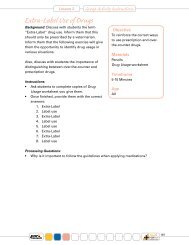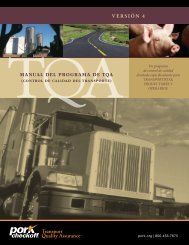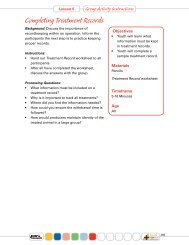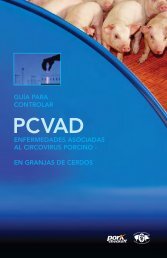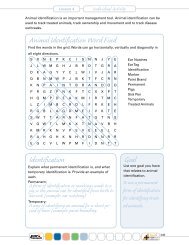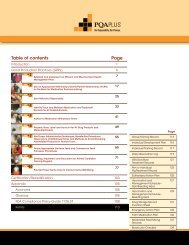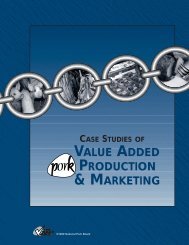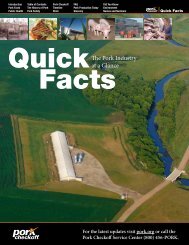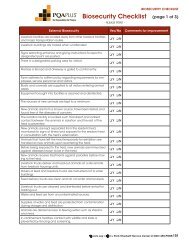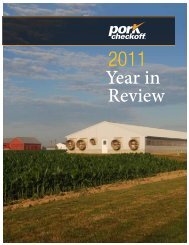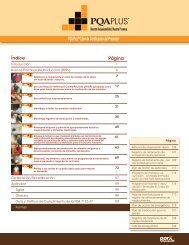PRRS Compendium Producer Edition - National Pork Board
PRRS Compendium Producer Edition - National Pork Board
PRRS Compendium Producer Edition - National Pork Board
Create successful ePaper yourself
Turn your PDF publications into a flip-book with our unique Google optimized e-Paper software.
<strong>PRRS</strong> virus primarily infects cells of the macrophage cell lineage. These cells are extremely important in a<br />
number of immunological responses, including the destruction of bacteria. Several groups have demonstrated<br />
that <strong>PRRS</strong> virus replicates in and damages pulmonary alveolar macrophages (PAMs) (Molitor et<br />
al., 1997; Thanawongnuwech et al., 1997, 1998a, 1998b) and pulmonary intravascular macrophages (PIMs)<br />
(Thanawongnuwech et al., 1997, 1998a, 1998b, 2000). One proposed hypothesis is that <strong>PRRS</strong> virus destroys<br />
the PAMs and PIMs, which are then replaced by immature cells that are less effective in containing bacterial<br />
infections, thereby resulting in pneumonia and septicemia (Pijoan et al., 1994). The fact that <strong>PRRS</strong> virus<br />
can persist in the bloodstream for several weeks despite the presence of anti-<strong>PRRS</strong>V antibodies certainly<br />
suggests that the immune system is not efficient in clearing <strong>PRRS</strong> virus infection. Complete clearance<br />
of <strong>PRRS</strong> virus often takes as long as 5 months in immunologically competent pigs (Allende et al., 1999).<br />
These remarkable findings emphasize the phenomenal challenges we face in preventing and/or controlling<br />
<strong>PRRS</strong> virus-associated disease outbreaks.<br />
Bacterial Co-infection Models<br />
Several groups have attempted<br />
to develop models<br />
to study <strong>PRRS</strong> virus<br />
co-infections with various<br />
bacteria. There is strong<br />
experimental evidence<br />
to support <strong>PRRS</strong> virusinduced<br />
predisposition<br />
to Streptococcus suis in<br />
nursery age pigs (Galina<br />
et al., 1994; Halbur et<br />
al., 2000; Thanawongnuwech<br />
et al., 2000) and in<br />
neonatal pigs from sows<br />
that were experimentally<br />
infected with <strong>PRRS</strong> virus<br />
in late gestation (Feng et<br />
al., 2001). There is also<br />
experimental evidence<br />
to support <strong>PRRS</strong> virusinduced<br />
increased susceptibility<br />
to Salmonella<br />
choleraesuis (Wills et al.,<br />
2000), Bordetella bronchiseptica<br />
(Brockmeier et al.,<br />
2000), and Mycoplasma<br />
hyopneumoniae (Thacker<br />
et al., 1999) infection and<br />
disease. Experimental efforts<br />
have been generally<br />
unsuccessful in demonstrating<br />
predisposition to<br />
disease induced by Haemophilus<br />
parasuis (Cooper<br />
et al., 1995; Segales<br />
et al., 1999; Solano et<br />
al., 1997), Actinobacillus<br />
pleuropneumoniae (Pol et<br />
al., 1997), or Pasteurella<br />
multocida (Carvalho et<br />
al., 1997). Table 1 summarizes<br />
much of the information<br />
in the literature<br />
Reference Coinfection Conclusions<br />
Brockmeier<br />
et al., 2000<br />
Carvalho et<br />
al., 1997<br />
Cooper et<br />
al., 1995<br />
Cooper et<br />
al., 1995<br />
Cooper et<br />
al., 1995<br />
Cooper et<br />
al., 1995<br />
Feng et al.,<br />
2001<br />
Galina et al.,<br />
1994<br />
Pol et al.,<br />
1997<br />
Segales et<br />
al., 1999<br />
Solano et<br />
al., 1997<br />
Thacker et<br />
al., 1999<br />
Thanawongnuwech<br />
et<br />
al., 2000<br />
Van Alstine<br />
et al., 1996<br />
Wills et al.,<br />
2000<br />
Bordetella bronchiseptica<br />
Pasteurella multocida<br />
Clinical disease was more severe in coinfected<br />
pigs.<br />
No clear interaction between <strong>PRRS</strong><br />
virus and Pasteurella multocida.<br />
Streptococcus suis No predisposition to S. suis.<br />
Salmonella choleraesuis<br />
Haemophilus parasuis<br />
Pasteurella multocida<br />
No predisposition to Salmonella choleraesuis.<br />
No predisposition to Haemophilus<br />
parasuis.<br />
No predisposition to Pasteurella multocida.<br />
Streptococcus suis In utero <strong>PRRS</strong> virus infection increases<br />
the susceptibility of neonates to S.<br />
suis.<br />
Streptococcus suis <strong>PRRS</strong> virus predisposed pigs to S. suis.<br />
Actinobacillus pleuropneumoniae<br />
Haemophilus parasuis<br />
Haemophilus parasuis<br />
Mycoplasma hyopneumoniae<br />
Minimal predisposition to Actinobacillus<br />
pleuropneumoniae.<br />
No predisposition to Haemophilus<br />
parasuis.<br />
No predisposition to Haemophilus<br />
parasuis.<br />
M. hyopneumonia infection potentiated<br />
the severity and duration of <strong>PRRS</strong><br />
virus-induced pneumonia.<br />
Streptococcus suis <strong>PRRS</strong> virus predisposed pigs to S. suis.<br />
<strong>PRRS</strong> virus strains differed in degree<br />
of predisposition to S. suis. <strong>PRRS</strong> virus<br />
MLV vaccines predisposed pigs to S.<br />
suis.<br />
Mycoplasma hyopneumoniae<br />
Salmonella choleraesuis<br />
No predisposition to Mycoplasma hyopneumoniae.<br />
Synergism of <strong>PRRS</strong> virus and Salmonella<br />
choleraesuis.<br />
Table 1: <strong>PRRS</strong> virus and bacterial coinfection models<br />
PAGE 1<br />
PIG 04-01-09





